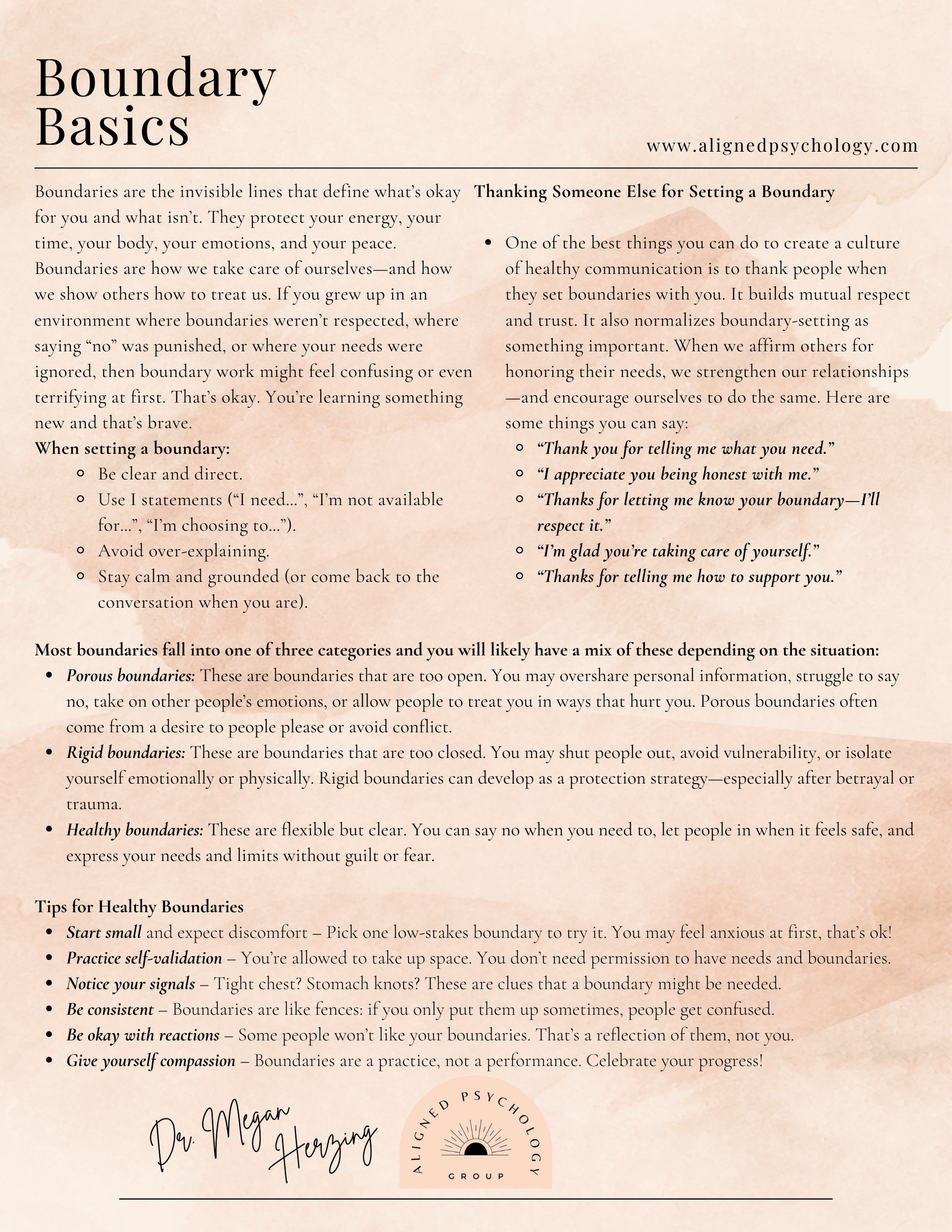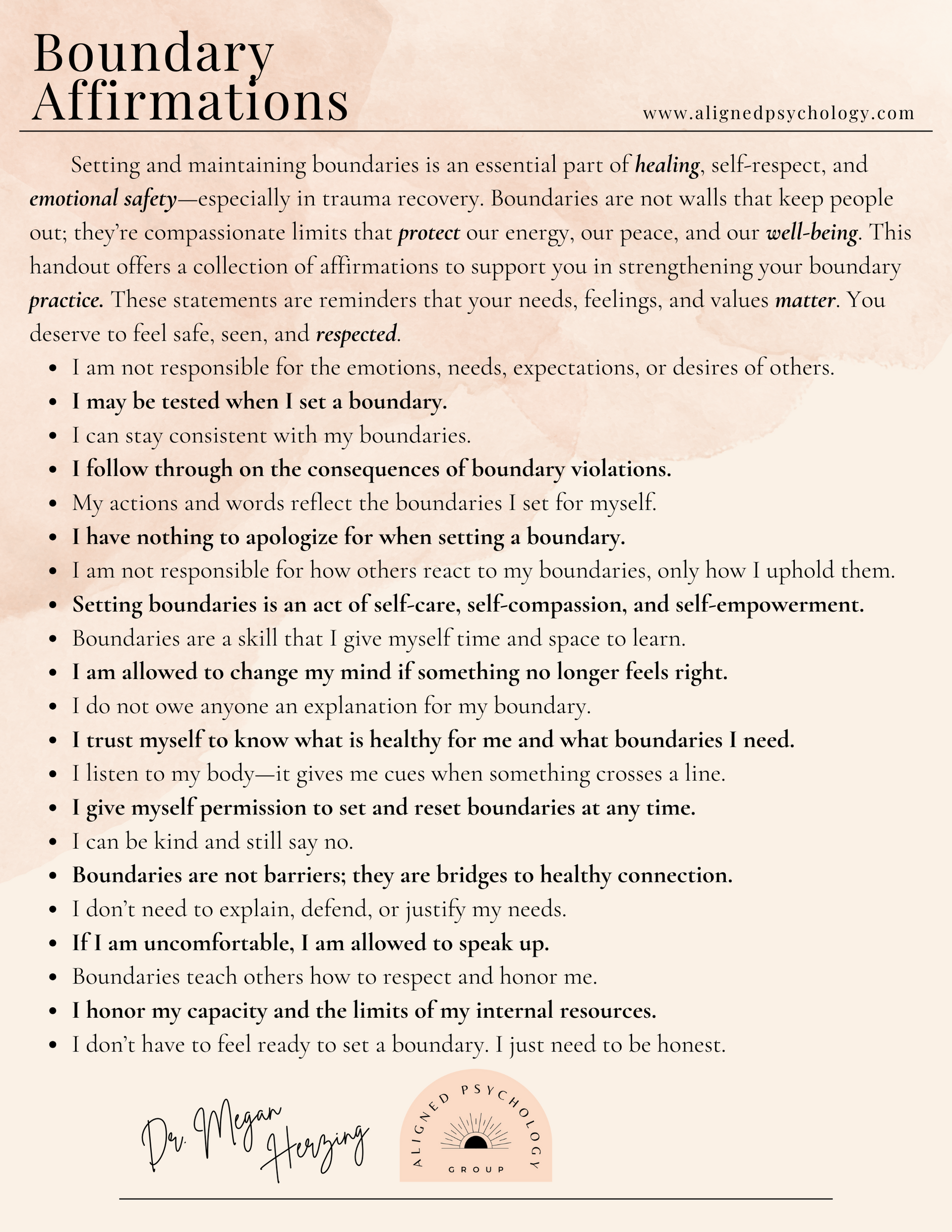Trauma Therapy Homework - Week 22
Week 22: (The Basics) Relationship Mini-Series
Boundaries
Welcome to Week 22 of your trauma therapy homework. This week we’re exploring a topic that comes up all the time in trauma recovery—and in life: boundaries. It’s one of those concepts that everyone talks about, but many of us were never actually taught how to understand, set, or maintain them. So let’s make some space to discuss it here!
Boundaries are the invisible lines that define for yourself and others what’s healthy, respectful, and sustainable in your relationships. They’re the internal guidelines that let others know how to treat you and what you will do to protect and care for yourself if you are not treated that way. They protect your energy, your time, your body, your emotions, and your peace. Boundaries are how we take care of ourselves—and how we show others how to treat us. If you grew up in an environment where boundaries weren’t respected, where saying “no” was punished, or where your needs were ignored, then boundary work might feel confusing or even terrifying at first. That’s okay. You’re not behind. You’re not doing it wrong. You’re learning something new—and that takes courage. Quick trigger warning in the category section: sexual boundaries. If this is too triggering for you, skip the last part of the section.

Types of Boundaries
Let’s start with a general framework for understanding boundaries. Most boundaries fall into one of three categories:
- Porous boundaries: These are boundaries that are too open. You may overshare personal information, struggle to say no, take on other people’s emotions, or allow people to treat you in ways that hurt you. Porous boundaries often come from a desire to people please or avoid conflict.
- Rigid boundaries: These are boundaries that are too closed. You may shut people out, avoid vulnerability, or isolate yourself emotionally or physically. Rigid boundaries can develop as a protection strategy—especially after betrayal or trauma.
- Healthy boundaries: These are flexible but clear. You can say no when you need to, let people in when it feels safe, and express your needs and limits without guilt or fear.
The goal here is awareness of your own types. Most of us have a mix of these depending on the situation, the person, or our stress level. The key is to notice your patterns with compassion and get curious about what you need.
Tips for Healthy Boundaries
Here are a few practical things to keep in mind as you practice boundary work:
- Start small – Pick one low-stakes situation to try it out.
- Expect discomfort – It’s normal to feel guilty or anxious at first. That doesn’t mean you’re doing it wrong.
- Practice self-validation – You’re allowed to take up space, have needs, and set boundaries. In fact, you deserve to. Your boundaries are valid.
- Use reminders – Write down the boundaries you’re working on. Post them where you can see them or create a note on your phone.
- Notice your body signals – Tight chest? Stomach knots? These are clues that a boundary might be needed.
- Be consistent – Boundaries are like fences: if you only put them up sometimes, people get confused.
- Get support – Process with someone you trust about your patterns in boundaries or what you want to work on.
- Be okay with reactions – Some people won’t like your boundaries. That’s a reflection of them, not you. They are allowed to have an emotional reaction to your boundary.
- Celebrate progress – Every time you speak up or hold a line, that’s a win. Honor it.
- Give yourself compassion – Boundaries are a practice, not a performance. Remind yourself that you are learning.

The Many Categories of Boundaries
Physical Boundaries – Involve personal space, touch preferences, and physical needs like food, rest, and movement. This includes:
- Asking for consent before physical touch
- Saying no to hugs or casual touch
- Preferring no one touches your things
- Walking away to create space
- Managing noise levels and requesting quiet
- Needing privacy or time to yourself
- Disliking being touched from behind
- Setting limits around physical closeness, like hugging or kissing
- Saying things like: “I feel uncomfortable with that,” or “Can you please not touch me like that?"
- You can also express physical boundaries nonverbally by stepping back or redirecting touch
- A helpful tool is the Green/Yellow/Red system. These are different for each person but here are some examples:
- Green (always okay): back scratches, hand holding, brushing hair
- Yellow (ask first): kissing in public, touching the stomach
- Red (never okay): feet, chest, or being touched from behind
Emotional Boundaries – Protecting your emotional energy, not taking on others’ emotions as your own, and not blaming others for your feelings. Examples include:
- Not sacrificing your goals or plans to please others
- Separating your emotional responses from someone else’s
- Working on not absorbing another’s stress or conflict
Intellectual Boundaries – Respecting differences in opinions, thoughts, or beliefs and knowing when and where it feels safe to engage in intellectual discussions. Includes:
- Choosing not to engage in debates or conversations on certain topics
- Saying, “I’d rather not discuss this,” "Let's change the topic please," or “Let’s agree to disagree.”
Material Boundaries – How you use, lend, or share your possessions, money, or resources. You might say:
- “I don’t lend out my car.”
- “I’m not comfortable sharing my food.”
Time Boundaries – Involve how you spend your time, including availability, punctuality, and capacity. Examples include:
- Saying no to events or last-minute plans
- Limiting time spent at work or school
- Needing alone time or rest
- Prioritizing time with friends or family
- Creating rules like, “No deep conversations after 8pm.”
- Canceling plans if you no longer feel you have the internal resources to engage.
Energetic Boundaries – Your sensitivity to other people's energy or moods, as well as your need for space or recharge time. Protecting your energy and personal bandwidth. You might need:
- Quiet time after socializing
- Rest between meetings
- Limited screen time
Digital Boundaries – How you engage in the digital world. Examples:
- Turning your phone off after a certain hour
- Unfollowing triggering content
- Limiting social media or screen time
- Curating your feed
- Saying, “I stop watching TV an hour before bed.”
Work Boundaries – Setting expectations around availability, responsibilities, and professionalism including workload, time off, and emails:
- “I don’t take calls after 6 pm.”
- Not answering work messages after hours or on weekends.
- “I need at least 24 hours to review documents.”
Spiritual Boundaries – Your beliefs, practices, and values around spirituality and rituals or lack thereof:
- “I’m not comfortable discussing religion.”
- “This practice isn’t aligned with my beliefs.”
Conversational Boundaries – Define what you’re willing to talk about and when. Use statements like:
- “I prefer not to talk about that.”
- “Can we change the subject?”
- “That topic feels triggering right now.”
- “Is now a good time to talk about something difficult, or would another time be better?”
- “Please don’t raise your voice with me.”
- “I’d appreciate being spoken to respectfully, even in disagreement.”
- “My opinions are just as valid.”
Financial Boundaries – Include how you spend, lend, or budget your money:
- “I can’t afford to contribute to that.”
- “I’m not comfortable discussing finances.”
Intimate Relationship Boundaries – Involve mutual respect and autonomy in a romantic connection:
- “My identity doesn’t depend on my partner.”
- “I maintain friendships and hobbies outside the relationship.”
- “I prefer no deep relationship talks after 7 pm.”
Sexual Boundaries – Sexual boundaries are essential for creating safe, respectful, and consensual experiences. They define what feels emotionally and physically safe for you in sexual and intimate settings. These boundaries vary from person to person and are deeply personal. Key aspects include consent, comfort levels, and safety around touch, preferences, and conversation. Important notes:
- Consent must be clear, mutual, and enthusiastic, and can be withdrawn at any time.
- Consent is a continual process.
- Consent can be verbal or nonverbal
- Sexual activity should only proceed when all parties feel fully safe and comfortable.
- Open communication is important about what is welcome, what is not, and what needs more conversation.
- Saying no to unwanted sexual jokes, innuendos, or sexualized comments.
- Setting clear boundaries around physical touch, including where, when, and how to be touched.
- Discussing preferences, limits, and comfort levels ahead of time or in the moment.
- Respecting the need to stop or pause at any point, without guilt or pressure.
- Checking in with your partner often during sexual encounters. Using check-in phrases like:
- “Can I touch you here?”
- "Are you comfortable with this?"
- “Is there anything you want to stop or change?”
- "Is there anything I can do differently to make this feel better?"
- “How are you feeling about this right now?”
- “Does this still feel good for you?”
- “Is this pace okay?”
- If you are reading nonverbal cues of discomfort:
- “Would you like me to slow down or stop?”
- “Do you need a break or some space?”
- Recognizing that digital sexual boundaries matter too (e.g., sexting, photos, sexual conversations).
- Refraining from making assumptions
- Understanding that a previous yes doesn’t mean a forever yes.
- Avoiding coercion, manipulation, or pressure for sexual activity.
- Respecting that a person can choose not to engage in any sexual activity at all.
- Being direct with preferences
- Not taking the preferences of others personally
What to Say and What to Do to Set Boundaries
Setting a boundary isn’t just about the words you say—it’s also about the actions you take to back them up. Let’s say someone constantly calls you late at night, even though you’ve asked them not to. You might say: “I’m not available to talk after 9pm. I need that time to wind down and rest.” If they keep calling, you follow through: You silence your phone or stop answering after 9pm. That’s the boundary in action. Saying the words is important. But consistently holding your line—even if others don’t like it—is what builds trust in yourself.
When setting a boundary:
- Be clear and direct.
- Use I statements (“I need...”, “I’m not available for...”, “I’m choosing to...”).
- Avoid over-explaining.
- Stay calm and grounded (or come back to the conversation when you are).

How to Say “No”
“No” is one of the most powerful boundary tools we have—and it’s also one of the most difficult to use if you struggle with people-pleasing or conflict avoiding. But here’s the truth: No is a full sentence. You don’t owe anyone an explanation. That said, it can help to have a few versions in your back pocket depending on the situation. Here are some examples:
- “No, thank you.”
- “I’m not available for that.”
- “That doesn’t work for me.”
- “I don’t have the capacity right now.”
- “I’m focusing on other priorities.”
- “Thanks for thinking of me, but I’ll have to pass.”
- “That’s not something I’m comfortable with.”
- “I’d rather not.”
- “I appreciate the offer, but I’m going to say no.”
You can be kind without being unclear. Boundaries don’t require justification. They require consistency.

Thanking Someone for Setting a Boundary
One of the best things you can do to create a culture of healthy communication is to thank people when they set boundaries with you. It builds mutual respect and trust. It also normalizes boundary-setting as something important.
Here are some things you can say:
- “Thank you for telling me what you need.”
- “I appreciate you being honest with me.”
- “Thanks for letting me know your boundary—I’ll respect it.”
- “I’m glad you’re taking care of yourself.”
- “Thanks for telling me how to support you.”
When we affirm others for honoring their needs, we strengthen our relationships—and encourage ourselves to do the same.
Final Thoughts
Setting boundaries is one of the deepest forms of self-respect. It’s how you say: My needs matter. My time and energy are important.
It’s also how you build healthier, more honest relationships—because the people who truly care about you will want to know what supports you. Boundaries aren’t walls—they’re bridges. They create safety, clarity, and connection. And they allow you to show up fully as yourself. So this week, give yourself permission to draw a line where you need one. Use your voice. Honor your limits. You’re not being selfish, you are taking care of yourself. You deserve to feel safe—in your body, your time, your space, and your relationships. Boundaries help make that possible. Keep going. You’re doing beautiful work.
FREE Downloadable Handouts
Click this LINK for free access to downloadable PDFs from the Trauma Therapy Homework Series. You’ll be directed to my Google Drive folder, where you can explore all the handouts created so far. You can choose between a digital format for easy viewing on your device or a printable version if you prefer a hard copy.
Here is a preview of this week's handout! Click the link above to get your own free pdf copy.




ABOUT THE AUTHOR
Dr. Megan
Megan Herzing PsyD, Licensed Professional Clinical Counselor, specializes in trauma therapy and creating a safe, supportive space for healing. She integrates evidence-based modalities, including EMDR, Internal Family Systems (IFS), somatic therapy, and Emotionally Focused Therapy (EFT), to address the mind-body connection and empower clients on their journey to wellness. With extensive experience treating complex PTSD, anxiety, attachment injuries, and dissociation, she believes in the power of self-compassion and authentic connection to facilitate lasting change. Drawing from her own healing journey, she brings empathy and lived experience to her work, honoring each client’s unique path toward growth and resilience.
Thank you for being part of a community of humans that deeply cares about healing.
We are honored that you stopped by and hope our resources will continue to bring value to your life.
We are accepting new clients in California, and referrals are always appreciated.












